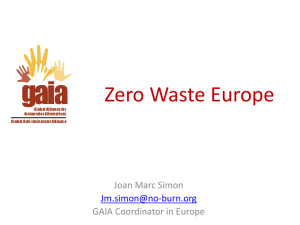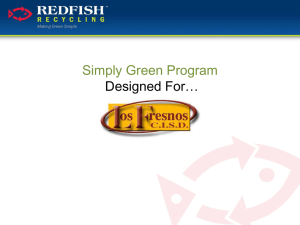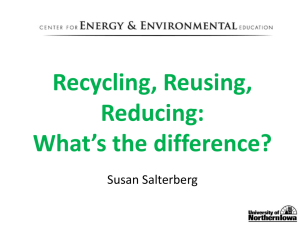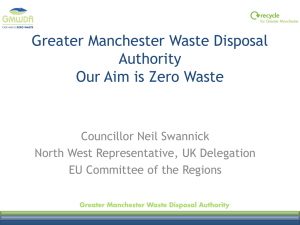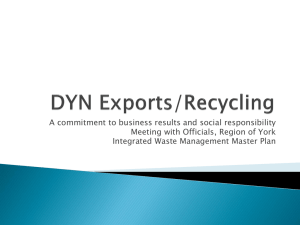Why Conservation Psychology?
advertisement
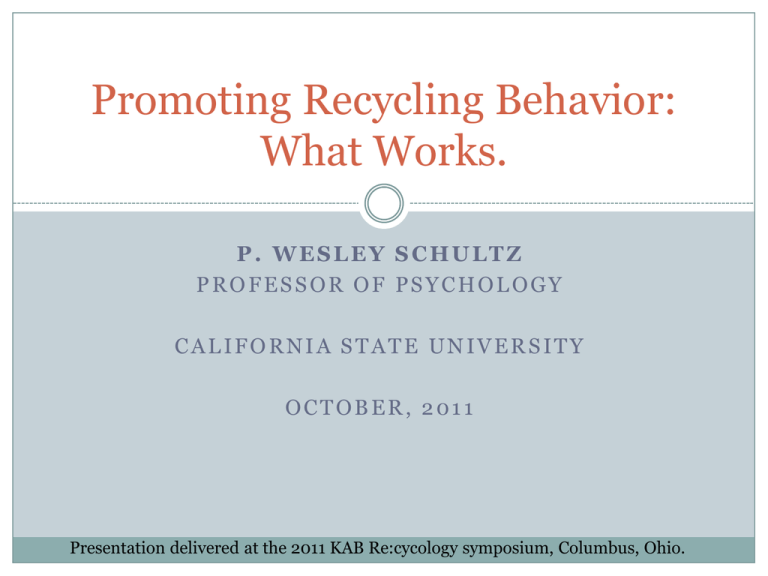
Promoting Recycling Behavior: What Works. P. WESLEY SCHULTZ PROFESSOR OF PSYCHOLOGY CALIFORNIA STATE UNIVERSITY OCTOBER, 2011 Presentation delivered at the 2011 KAB Re:cycology symposium, Columbus, Ohio. Recycling Figures Average American generates 4.5 pounds of trash per day Municipal waste (2008) Residential, commercial, institutional Not hazardous, industrial, or construction Diversion rates vary widely CA at 60% diversion Many notable programs Ready-Set-Recycle (competition in Alameda, CA) Fork it over! (Portland, OR) Green-Dot (Germany, and Europe) Anheuser-Bush “Brewing a Better Environment” Organics recycling in Halifax, Canada MilwaukeeRecycles.com (Recycle for Good) Community-Based Social Marketing www.cbsm.com Effective approach to behavior change Origins in behavioral science research Five step, data-driven process “Community” based Removes barriers and enhance benefits The Science of Behavior Osbaldiston & Schott (2011) Review of behavioral science 40 years of data on proenvironmental behavior (35 with recycling) 253 experimental treatments (primarily recycling, conservation) 10 types of treatments Differentiated public recycling, curbside recycling, central recycling What Works. Convenience Social Modeling Prompts Cognitive Dissonance Justifications Feedback Education Commitment Rewards Goal Setting What Works? Meta analysis of recycling studies, combined across three types of programs. N=41 public, N=52 curbside, N=18 central collection. Osbaldiston & Schott (2011) Different Types of Recycling Meta analysis of recycling studies, combined across three types of programs. N=41 public, N=52 curbside, N=18 central collection. 1. Information is (generally) Not Sufficient Knowledge-deficit model Knowledge is (often) correlated with behavior Education and information can increase knowledge Increasing knowledge will (typically) not result in behavior change. 2. Pledges and Commitments Can be a very useful tool for promoting recycling. Public and durable Specific (time, place, material) Be mindful of individuals who choose not to sign. 2. Pledges and Commitments “We, the residents of the 2nd floor, are willing to participate in the paper recycling project sponsored by the Reed College Environmental Group. It is understood that any recyclable paper can be placed in the “RECYCLE” garbage can. We commit ourselves to participating in this recycling project for the next four weeks.” – Wang & Katzev I PLEDGE TO: Learn. about the recycling option in my community. I will find out what materials are collected for recycling in my community at americarecyclesday.org. I PLEDGE TO: Act. Reduce my personal waste by recycling. Within the next month, I will start to recycle one new type of material. 3. Financial Incentives Incentives can change behavior Will hear more from John Thogersen tomorrow But: 1. 2. 3. 4. Framing behavior as transaction creates expectations Behavior and context specific Size matters Undermining 4. Infrastructure Make it EASY Reduce uncertainty (shapes of the holes, signage) Allow people to anticipate Entry and exit locations Proximal to behavior Remove barriers for example, lids 5. Signage Will hear more from Carol Werner tomorrow. Signs can make a big difference (both positive AND negative) Positive, simple behavior, already motivated, prompts, proximal Mindful of contextual norm 6. Persuasion Can have a role, but perhaps limited “Behaving people into thinking differently” Some evidence for personal norms (moral obligation). Hard to promote through messaging, better to induce behavior first Social Norms Social Norms Normative Social Influence --Curbside recycling 7. Social Norms Curbside recycling (Schultz, 1999) Mandated by most CA cities in order to meet 50% diversion requirements set by State. Field experiment with 600 households for 8 weeks Information, no treatment control, descriptive normative feedback Baseline (4 weeks), intervention (4 weeks), follow-up (4 weeks) Normative-based Messages Normative Feedback Information Only No Treatment (control) Change from baseline to follow-up for the normative feedback condition is significant (p<.05), and corresponds to a 19% increase in recycling rates! Source: Schultz, P. W. (1999). Changing behavior with normative feedback interventions: A field experiment of curbside recycling. Basic and Applied Social Psychology, 21, 25-36. Conclusions Recycling is a behavior Behavioral scientists have been studying recycling for 35+ years Some clear lessons Encourage programs to draw on this knowledge Get to know your local behavioral scientist Social Norms Social Norms References Bator, R., Bryan, A., & Schultz, P. W. (2011). Who gives a hoot? Intercept surveys of litterers and disposers. Environment and Behavior, 43, 295-315. Osbaldiston, R., & Schott, J. (in press). Environmental sustainability and behavioral science: Meta-analysis of pro-environmental behavior. Environment and Behavior. Schultz, P. W., Bator, R., Tabanico, J., Bruni, C., Large, L. B. (in press). Littering in context: Personal and environmental predictors of littering behavior. Environment and Behavior. Schultz, P. W., Khazian, A., & Zaleski, A. (2008). Using normative social influence to promote conservation among hotel guests. Social Influence, 3, 4-23. Schultz, P. W. (1999). Changing behavior with normative feedback interventions: A field experiment of curbside recycling. Basic and Applied Social Psychology, 21, 25-36. Schultz, P. W., & Kaiser, F. G. (in press, estimated 2011). Promoting proenvironmental behavior. In S. Clayton (Ed.), Handbook of environmental psychology. Oxford University Press. Oskamp, S., Zelezny, L., Schultz, P. W., Hurin, S., Burkhardt, R., (1996). Commingled versus separated recycling: Does sorting matter? Environment and Behavior, 28, 73-91. Schultz, P. W., & Oskamp, S., & Mainieri, T. (1995). Who recycles and when: A review of personal and situational factors. Journal of Environmental Psychology, 15, 105-121. Don’t Throw in the Towel! Note: My appreciation to the team of CSUSM students who worked on this experiment: Azar Khazian, Michelle Hynan, Joy Francisco, Christine Jarvis, and Jenny Tabanico. Old Message: Different Rooms Hotel Study -- New Message Social Norm Messages Hotel Intervention • Study focused on 132 condo units (separate studies of hotel) • Randomly assigned rooms to experimental (N=102) or control (N=30) • Total of 794 guest “stays” were analyzed (each stay = 1 week) • Number of towels taken from the room (continuous up to 4) Results Number of towels taken out of the room on the first towel replacement day. F(1,792)=13.40; p<.001). A 25% reduction in the number of towels used! Note: Data also tested in HLM with participant “nested” within room. ICC=.07; At level 2, treatment effect ( γ01=-.57, t(142.14)=-3.25, p<.001)

